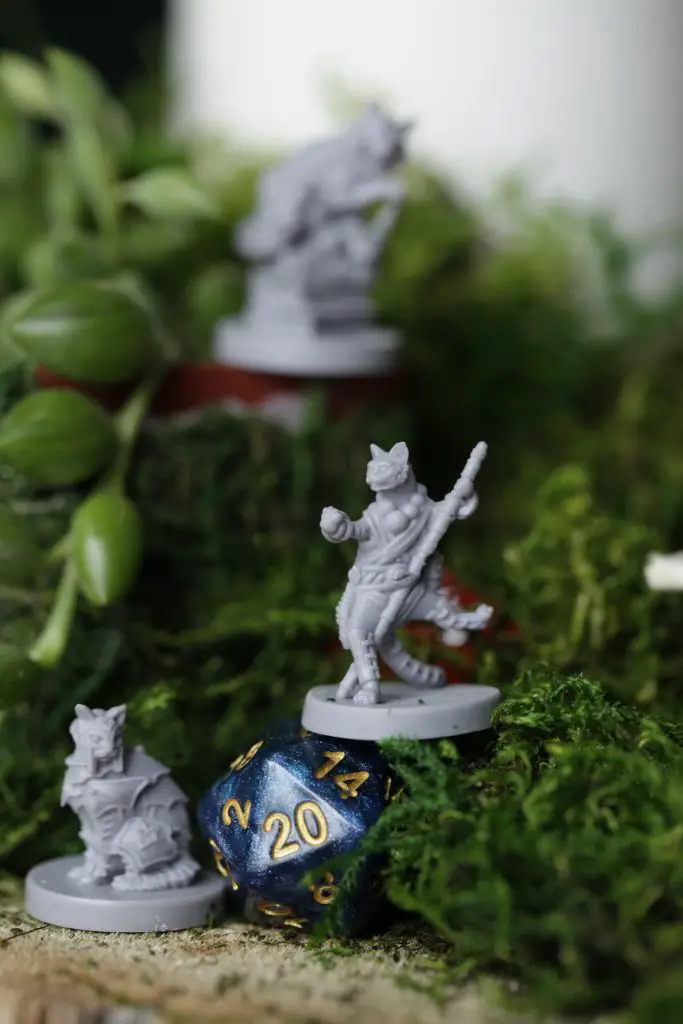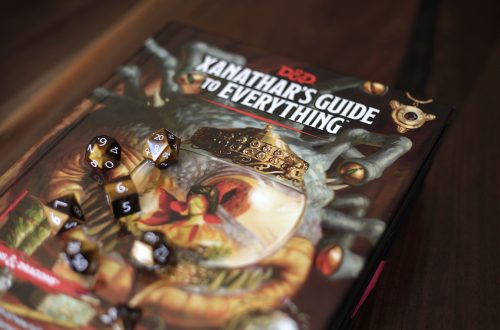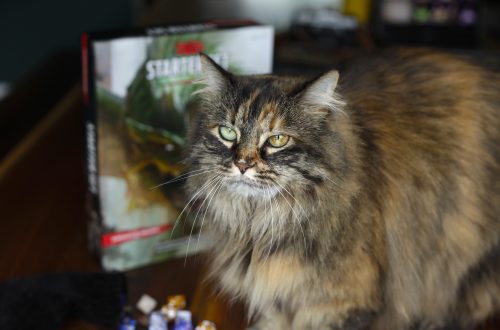The D&D 5e Multiclassing Guide You Need to Read
Hey there! This website does contain affiliate links. If you purchase something through this page, Cats and Dice may earn a share of sales from the link. Learn more.
Sometimes, your rogue can’t get sneak attack in as often as you’d like. Other times, your ranger needs to get some good melee hits in. Or sometimes, your barbarian just wants to cast a few spells. For all this, you need multiclassing. And to understand multiclassing, this is the D&D 5e multiclassing guide you need to read.
Multiclassing does not need to be complicated in 5th edition. Since it is an optional ruleset, though, it’s important to understand how it works before you decide to build a monk-sorcerer-bard (or whatever cool combination you’re thinking of). You will want to make sure you understand what multiclassing entails and whether or not you meet the requirements to do it before you try. For any multiclassing question you have, we have the answers in this D&D 5e multiclassing guide.
What is D&D Multiclassing in 5e?
Every character in Dungeons and Dragons starts out with a single class. That class determines the character’s skill set. Some classes specialize in spellcasting, while others are great melee fighters. Your class will affect how you play the game, not only in combat, but through your backstory and roleplaying choices, too.
Once a character reaches a higher level, you can have them multiclass according to the ruleset available on pages 163-165 in the Player’s Handbook. This means that the character will now have more than one class, giving them more abilities beyond what a single class can do. We’ll simplify the official ruleset first. Then, let’s talk more later about why multiclassing might be a good or bad choice for your D&D character.
Who can Multiclass in 5e?
Before you go any further with D&D multiclassing, ask your Dungeon Master if they allow multiclassing in their game. Like feats and flanking, multiclassing is an optional ruleset. Whether or not your DM allows multiclassing, you will still want to read this D&D 5e multiclassing guide to understand why or why not. But the DM’s ruling is required before you can multiclass.
Then, anyone can multiclass once two ruleset conditions are met:
- They level up.
- They meet the ability score minimums.
The prerequisites for a class involve having a minimum of 13 in the most relevant score for that class. The chart below gives you the exact ability score you need to multiclass in every D&D 5e class. You can also find (most of) this chart on page 163 of the Player’s Handbook.
| Class | Ability Score Minimum |
| Artificer* | Intelligence 13 |
| Barbarian | Strength 13 |
| Bard | Charisma 13 |
| Blood Hunter* | Strength 13 or Dexterity 13, and Intelligence 13 |
| Cleric | Wisdom 13 |
| Druid | Wisdom 13 |
| Fighter | Strength 13 or Dexterity 13 |
| Monk | Dexterity 13 and Wisdom 13 |
| Paladin | Strength 13 and Charisma 13 |
| Ranger | Dexterity 13 and Wisdom 13 |
| Rogue | Dexterity 13 |
| Sorcerer | Charisma 13 |
| Warlock | Charisma 13 |
| Wizard | Intelligence 13 |
Remember, this is for both the class you wish to multiclass to and the class you currently are. So if you are a Barbarian who wants to multiclass into a Warlock, you need a Charisma score and a Strength score of at least 13.

How Does Multiclassing Work in D&D?
Once you’ve met the minimum requirements outlined above and your character levels up, you can now have them multiclass.
Whenever a character levels up, there are potentially changes to their levels, experience points, hit dice, proficiency bonus, spells, spell slots, and features. Some of these things add to each other when multiclassing, and some of them do not. Here is the breakdown for each kind of change.
Levels and Experience Points
When you multiclass, you take different levels in each class, which lead to a combined overall level. For example, if you are a Level 5 Fighter who multiclasses into a Rogue at your next level, that means you are a Level 5 Fighter and a Level 1 Rogue for a combined character level of 6. Once you reach level 7, you will decide which class you want to level up (or choose a third one!).
Just like levels, your experience points equal your overall level and are not separated. So to get the character above to Level 7, you will still need to reach 23,000 XP as shown by the chart on page 15 of the Player’s Handbook.
Hit Dice
Hit dice are much simpler. You simply take the hit dice for that class equal to the level for that class. Just like with a single class, you always get hit dice equal to your current level. A Level 5 Fighter has 5d10 hit dice, while a Level 1 Rogue has 1d8 hit dice. That would mean your Level 6 character would have 5d10 and 1d8 hit dice. Should your classes happen to have the same type of hit die, then they stack.
Proficiency Bonus
This one is even easier. Your proficiency bonus always matches the chart on page 15 of the Player’s Handbook for your combined overall level. In other words, multiclassing does not change anything about your proficiency bonus.
Spell Slots
Spell slots (not to be confused with spells themselves, discussed in the features section) are easy if you are not already a spell caster like a monk or a barbarian. You just get the abilities for the levels in your new spellcasting class.
If your character is already a spellcaster multiclassing into another type of spellcaster, things start getting specific for each class. That’s because some classes rely on spellcasting more heavily than others.
First, a rule for multiclassing in all spellcasting classes: your spell slots per level remain roughly the same as if you had not multiclassed. In other words, your spell slots do not simply add together for each class.
Instead, visit the chart on page 165 of the Player’s Handbook to calculate your specific spell slots. Or, you can use this cool spell slot calculator.
To calculate the spell slots for your D&D multiclassing character, go through these steps:
- Add all your levels in bard, cleric, druid, sorcerer, and wizard together.
- Halve your levels in paladin and ranger rounded down.
- Halve your levels in artificer rounded up.
- Third your levels in fighter and rogue (if you are an Eldritch Knight or Arcane Trickster).
Once you’ve added these totals together, you will have a calculation for how many spell slots you have and in which level with the help of the Handbook’s chart.

Features
Each class also comes with unique features (not to be confused with feats). Some features stack and some do not.
Generally speaking, you gain the features for your level in that class. For example, a level 1 barbarian can rage, no matter what levels you have in anything else. A level 2 rouge can bonus action disengage or hide. Whatever features your class has at that level, you generally gain them.
However, some class features do not stack if you already have them. Channel Divinity, Unarmored Defense, or Extra Attack are all features that you do not get more than once, even if you have multiclassed into multiple classes that have these features.
Spells work in a similar way. You do not get to learn a high-level spell as a high-level character just because you took one level in spellcasting. A character who multiclasses into a wizard, for example, can only choose spells from the Level 1 Wizard spell list.
As a result, if you multiclass into two spell casters, you might have spell slots for levels of spells you cannot cast. You can instead use those higher-level spell slots to cast lower-level spells at a higher level.
You do get a new set of cantrips by multiclassing into two classes of spellcaster, though, but only for your new spellcaster class. In other words, if you were originally a bard and take a level in cleric, you will get new cleric cantrips but not new bard cantrips.
Subclasses
Currently, there is no official way to multiclass between several subclasses of the same class. In other words, the rules do not give the option to stack subclasses of the same class. A druid cannot be part of both the Circle of the Moon and the Circle of Dreams, for example. This is probably because subclass abilities do not occur in a uniform way and were not built for picking and choosing.
This does not mean that your Dungeon Master would not allow multiclassing in subclasses of the same class. If they do, though, it would be a homebrew option and not part of any official ruleset.
Why Multiclass?
Now that you know the how of D&D multiclassing, you might be wondering why you would multiclass. Alternatively, you may have come to this D&D multiclassing guide knowing exactly why you want to multiclass but haven’t considered why you would not multiclass. Take a moment to consider the options now.
Roleplay
First, you might multiclass for roleplaying reasons. Some common in-game reasons to multiclass in D&D are below.
- Friendship: Your character might have learned a great deal from another character of another class.
- Necessity: Hard times might have required a character to develop skills in another class.
- Opportunity: A character might have had the opportunity to learn or train with someone in a certain class. Similarly, they might have come across an inspirational item.
Many roleplaying reasons can justify multiclassing. Just make sure your Dungeon Master agrees first.
Combat
Some players multiclass to optimize a character and make them as strong as they can be. Certain multiclassing combinations can create powerful results in combat. For example, multiclassing as a barbarian/rogue can be quite powerful when you consider the following combat example:
- Use a bonus action to rage in your barbarian class, giving you advantage on the attack.
- Use your action to attack a monster with advantage.
- Should that attack hit, you will get to roll sneak attack damage from your rogue class because you had advantage on the attack as a barbarian.
D&D multiclassing, when carefully considered, can provide all kinds of powerful and interesting combat combinations.

Why Not Multiclass?
Everything up to this point may have sounded like a strong pitch in favor of multiclassing. So why wouldn’t you have your character multiclass? There are a few reasons, but they are also good ones.
Your Dungeon Master does not allow multiclassing.
This is the most straightforward reason to not multiclass. There are many reasons a DM might not allow it. They might consider it difficult to track, imbalanced, unfair, or unfitting to their game.
If your DM does not allow multiclassing, it may be worth having a short and open discussion about it. Consider pointing them to this D&D multiclassing guide if they have questions. But if your Dungeon Master has settled on not allowing multiclassing, do not push the issue. Multiclassing is an optional ruleset, and it is the DM’s right not to use it.
You will miss out on higher-level features.
Your character’s overall level still maxes out at Level 20 when multiclassing. That means you will miss out on some higher-level features. Multiclassing is not inherently the most powerful way to play a character for this reason.
Spellcasters, in particular, might not ever access 9th-level spells if they multiclass too much, even if they have 9th-level spell slots. Again, you can only access spells available to your character’s level in that particular class, so if your wizard never reaches level 17, then they’ll never get that sweet, sweet Wish spell.
Beyond This D&D 5e Multiclassing Guide
On the off-chance this D&D 5e multiclassing guide did not cover what you need, there are a couple of resources we recommend to accompany it. First, make sure you have a copy of the Player’s Handbook, and read the section on multiclassing thoroughly. (It is found on pages 163-165.)
Then, watch the Handbook Helper on D&D 5e multiclassing below.
Finally, make sure to share your thoughts and questions in the comments below. Does anything still confuse you? As a seasoned player, do you have recommendations to players multiclassing for the first time? Share them in the comments to contribute to the best D&D 5e multiclassing guide.
Hi there! I’m Kristen. I’m a game writer, a Dungeon Master, and like you, I love tabletop games. Visit our About page to learn more about me.
I wrote this Cats and Dice article to help you enjoy gaming even more. Did it help? If so, our kitties (and our site) would be grateful for a little gift through Ko-Fi.





